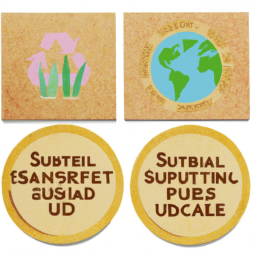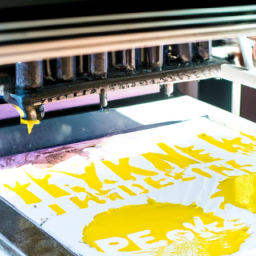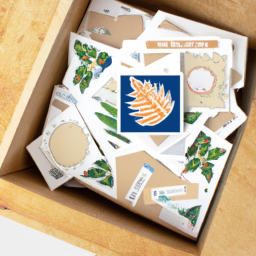Are you looking to make your own eco friendly stickers? In this article, we will show you how to create sustainable stickers using materials that are good for the environment. You’ll learn about choosing eco-friendly materials, selecting non-toxic inks and adhesives, and using printing techniques that minimize waste. We’ll also cover cutting and shaping methods, packaging and shipping practices, and marketing strategies for promoting your eco friendly stickers. Let’s get started on your journey towards environmentally conscious sticker production.
Choosing Sustainable Materials

When choosing sustainable materials for eco-friendly stickers, it’s important to consider their impact on the environment. Sustainable production methods and eco-friendly alternatives are key factors to consider. By opting for sustainably sourced materials, you can contribute to reducing deforestation and habitat destruction. Look for options such as recycled paper or biodegradable materials derived from renewable resources like bamboo or sugarcane.
Recycled paper is an excellent choice as it helps reduce waste and saves trees from being cut down. It requires less energy and water compared to traditional paper production processes. Additionally, using biodegradable materials ensures that the stickers will break down naturally over time, minimizing their environmental impact.
Another sustainable option is vegetable-based inks instead of petroleum-based ones. Vegetable-based inks are made from renewable resources like soybeans, which significantly reduces the emission of volatile organic compounds (VOCs) during printing.
To further enhance sustainability, consider working with suppliers who prioritize ethical practices throughout their supply chain. This includes ensuring fair labor conditions and reducing carbon emissions associated with transportation.
Designing Your Eco Friendly Sticker

Designing your environmentally conscious sticker can be a creative and sustainable way to express your brand. When it comes to color options, there are various eco-friendly alternatives to traditional inks that you can consider. Vegetable-based inks, for example, are made from renewable resources and do not contain harmful chemicals like petroleum-based inks do. These inks come in a wide range of vibrant colors, allowing you to create eye-catching designs without compromising on sustainability.
In terms of pricing strategies, it’s important to note that eco-friendly stickers may require a slightly higher investment compared to regular stickers. This is because the materials used are often more expensive due to their sustainable nature. However, this extra cost can be justified by positioning your brand as environmentally responsible and appealing to consumers who prioritize sustainability.
To ensure that you get the most out of your investment, consider placing your eco-friendly sticker on products or packaging that align with your brand’s values. This will not only enhance the overall aesthetic appeal but also reinforce your commitment towards sustainability.
Selecting Non-Toxic Inks and Adhesives

To ensure the safety of your customers, it’s important to select non-toxic inks and adhesives for your stickers. When sourcing eco-friendly materials for your sticker production, you should prioritize ink and adhesive options that are free from harmful chemicals. Non-toxic inks are typically made from plant-based or water-based formulations, which significantly reduce the environmental impact compared to traditional solvent-based inks.
Water-based inks are a popular choice as they have lower volatile organic compound (VOC) emissions and fewer hazardous air pollutants. They also offer excellent color vibrancy and durability. Plant-based inks, on the other hand, are derived from renewable resources like soybeans or vegetable oils. These inks possess similar properties to their petroleum-derived counterparts but have a reduced carbon footprint.
When it comes to selecting adhesives for eco-friendly stickers, opt for water-based or natural rubber adhesives instead of those containing harmful chemicals such as formaldehyde or phthalates. Water-based adhesives provide strong bonding capabilities while being safer for both humans and the environment. Natural rubber adhesives are derived from sustainable sources and offer excellent biodegradability.
Printing Techniques for Eco Friendly Stickers

Printing techniques like offset printing or screen printing offer eco-friendly options for creating stickers. These methods are known for their ability to reduce waste in sticker production, making them a sustainable choice for environmentally conscious individuals and businesses.
Offset printing, for example, uses plates to transfer ink onto the sticker material. This process allows for precise color reproduction and high-quality prints while minimizing the amount of wasted ink. Additionally, offset printing can be done on recycled paper or other eco-friendly materials, further reducing its environmental impact.
Screen printing is another popular technique that offers eco-friendly benefits. It involves pushing ink through a mesh screen onto the sticker material. This method allows for vibrant colors and durable prints while using minimal amounts of ink. Screen printing also enables easy customization and is compatible with various types of eco-friendly substrates.
Cutting and Shaping Your Stickers

When cutting and shaping your stickers, you’ll have the freedom to create unique and eye-catching designs. To further enhance the eco-friendliness of your creations, consider using recycled paper and eco-friendly cutting tools.
Using recycled paper for your stickers is an excellent way to reduce waste and minimize your impact on the environment. Recycled paper is made from post-consumer waste, such as old newspapers or discarded office papers. By opting for this sustainable option, you help conserve precious natural resources like trees and water while reducing energy consumption during production.
In addition to choosing sustainable materials, it’s essential to use eco-friendly cutting tools. These tools are specifically designed to minimize waste and environmental harm. They often feature sharp blades that ensure precise cuts without excessive tearing or damage to the sticker material. Look for options made from recycled or biodegradable materials, which can be easily disposed of in an environmentally friendly manner.
Packaging and Shipping With the Environment in Mind

Packaging and shipping your stickers with the environment in mind involves using sustainable materials and minimizing waste. To reduce the environmental impact of sticker production, carbon offsetting is a key strategy. This process involves calculating the carbon emissions generated during sticker manufacturing and finding ways to compensate for them. By investing in renewable energy projects or reforestation initiatives, companies can offset their carbon footprint.
Additionally, implementing a recycling program for sticker waste is crucial. Stickers often end up in landfills due to their adhesive properties, but with proper recycling efforts, this waste can be minimized. Recycling facilities can separate the paper backing from the adhesive material, allowing each component to be recycled separately.
When it comes to packaging, using eco-friendly materials is essential. Opting for recyclable or biodegradable packaging not only reduces waste but also prevents harmful chemicals from entering the environment.
Furthermore, reducing excess packaging is important. By choosing appropriately sized envelopes or boxes for shipping, you can minimize unnecessary materials and lower transportation-related emissions.
Marketing and Promoting Your Eco Friendly Stickers

Now that you have successfully packaged and shipped your eco-friendly stickers, it’s time to focus on marketing and promoting them. One crucial aspect is finding reliable eco-friendly sticker suppliers who can provide you with high-quality materials. Look for suppliers who prioritize sustainability, use recycled or biodegradable materials, and have certifications such as Forest Stewardship Council (FSC) or Sustainable Forestry Initiative (SFI).
When considering eco-friendly sticker pricing, it’s important to strike a balance between affordability and profitability. Conduct market research to understand the average pricing for similar products in your target market. Keep in mind that customers are often willing to pay a premium for environmentally friendly products.
To ensure profitability, carefully calculate your costs including raw materials, production, packaging, and shipping expenses. Factor in any additional costs associated with being eco-friendly such as certifications or special manufacturing processes. Determine a reasonable profit margin without compromising your commitment to sustainability.
Once you have determined the pricing structure and profitability of your eco-friendly stickers, it’s time to promote them effectively. Utilize social media platforms like Instagram or Facebook to showcase their unique features and environmental benefits. Collaborate with influencers or bloggers who align with your brand values to reach a wider audience. Consider participating in relevant trade shows or local markets where you can engage directly with potential customers.
Maintaining Sustainability Practices in Sticker Production

To ensure your commitment to sustainability in sticker production, it’s important to regularly review and update your manufacturing processes for maximum eco-friendliness. One key aspect of maintaining sustainability practices is sourcing eco-friendly materials. Look for suppliers who offer materials that are biodegradable, recyclable, or made from renewable resources. By using these materials, you can minimize the environmental impact of your sticker production.
Another important factor in maintaining sustainability is minimizing waste during production. Implementing efficient manufacturing techniques can help reduce waste and conserve resources. For example, consider using digital printing instead of traditional methods like screen printing, as it generates less waste and requires fewer raw materials. Additionally, optimize your cutting process to minimize material wastage.
Regularly monitoring and evaluating your manufacturing processes will allow you to identify areas where improvements can be made in terms of eco-friendliness. Collect data on energy consumption, water usage, and waste generation to track progress over time. Use this information to make informed decisions about implementing new technologies or procedures that can further enhance sustainability.
Frequently Asked Questions
Can I Use Regular Printer Ink for Eco Friendly Stickers?
You cannot use regular printer ink for eco friendly stickers. Regular printer ink is not environmentally friendly and can have negative impacts on the environment. However, there are alternatives to regular printer ink that are more eco friendly. These alternatives include vegetable-based inks, soy-based inks, and water-based inks. These types of inks are made from renewable resources and have lower levels of volatile organic compounds (VOCs), making them a better choice for creating eco friendly stickers.
How Can I Ensure My Stickers Are Biodegradable?
To ensure your stickers are biodegradable, it’s important to use eco-friendly sticker materials. Look for options made from sustainable materials like recycled paper or plant-based alternatives such as bamboo or cornstarch. These materials break down naturally over time, reducing their impact on the environment. Avoid using vinyl or plastic-based materials that take years to decompose. By choosing biodegradable sticker materials, you can contribute to a more sustainable and eco-friendly future.
Are There Any Specific Design Elements That Make a Sticker Eco Friendly?
When it comes to eco-friendly sticker designs, there are certain elements you can consider. Using minimalistic designs with clean lines and simple shapes can help reduce the use of ink and materials. Opting for natural or recycled materials for your stickers, such as biodegradable paper or plant-based adhesives, also contributes to their eco-friendliness. Additionally, using water-based inks instead of solvent-based ones further reduces the environmental impact. By incorporating these design choices and materials, you can create stickers that are both visually appealing and environmentally conscious.
Is It Possible to Make Stickers Using Recycled Materials?
Yes, it is possible to make stickers using recycled materials. Using recycled paper for eco friendly stickers helps reduce the demand for new paper production and saves trees. Additionally, exploring natural adhesive options for eco friendly stickers can further minimize environmental impact. By opting for adhesives derived from renewable resources or plant-based materials, you can create stickers that are both visually appealing and environmentally conscious.
What Are Some Sustainable Alternatives to Plastic Packaging for Eco Friendly Stickers?
Sustainable packaging options for eco friendly stickers include biodegradable materials like compostable paper or cardboard, as well as plant-based alternatives such as cornstarch or sugarcane-based polymers. These alternatives provide several benefits, such as reducing plastic waste and minimizing environmental impact. By using eco friendly stickers with sustainable packaging, you can contribute to a healthier planet by avoiding the use of non-recyclable plastics and promoting a more circular economy.
Conclusion
In conclusion, by following the steps outlined in this article, you can successfully create eco-friendly stickers. By choosing sustainable materials, using non-toxic inks and adhesives, and implementing environmentally conscious printing techniques, you can reduce your impact on the planet. Additionally, considering the cutting and shaping process, packaging and shipping methods, as well as marketing strategies that align with sustainability practices will further enhance your efforts. Remember to consistently maintain these practices to ensure a greener sticker production process.